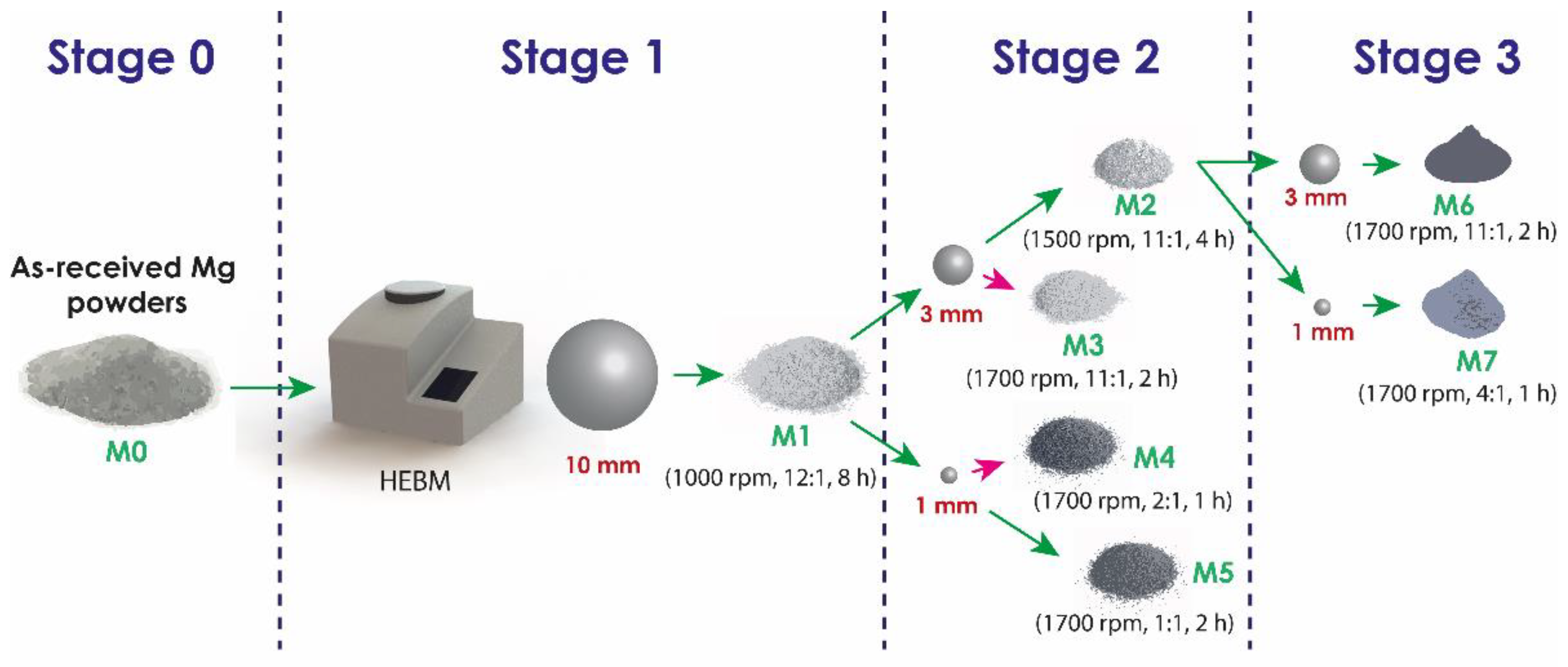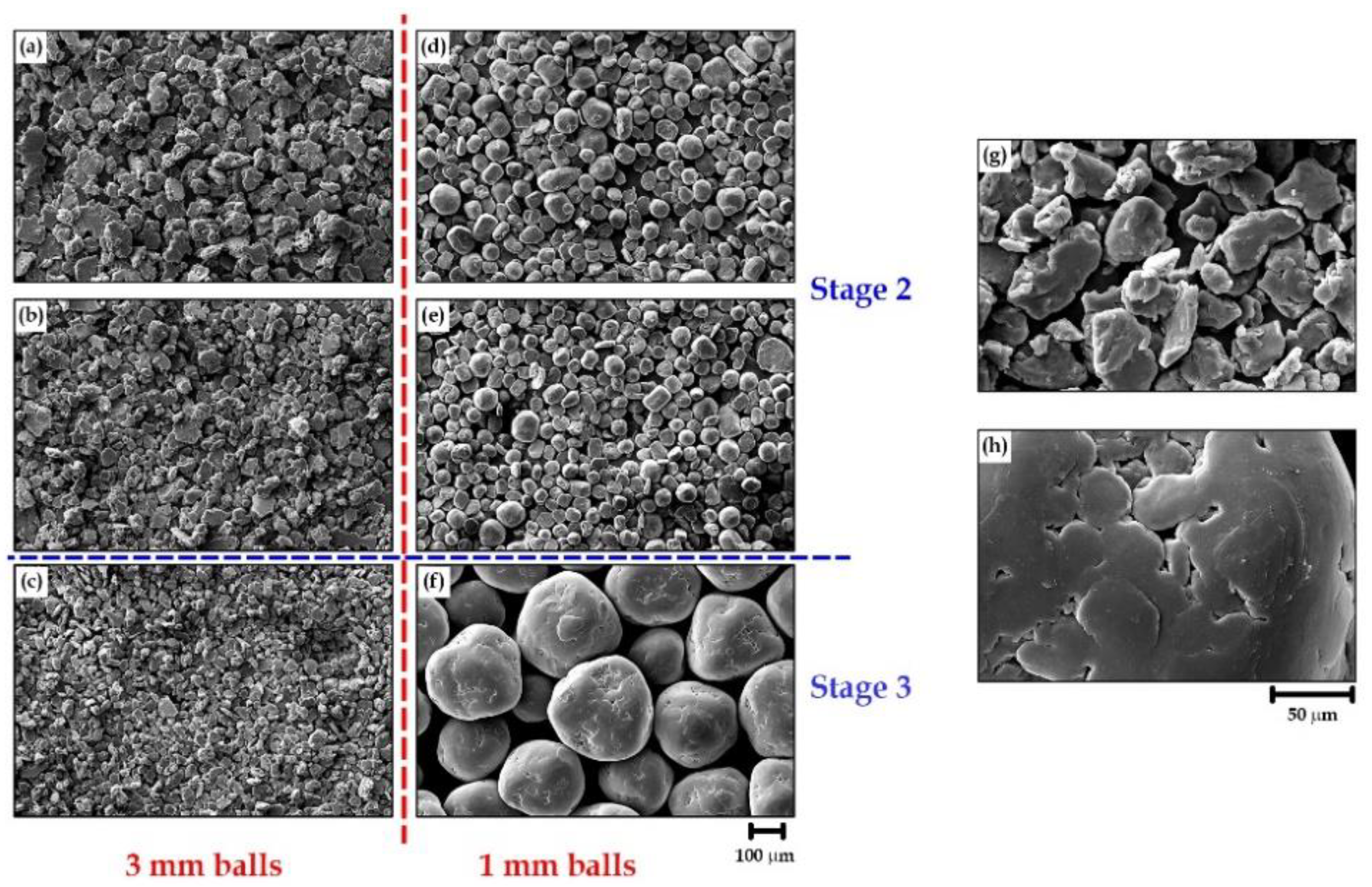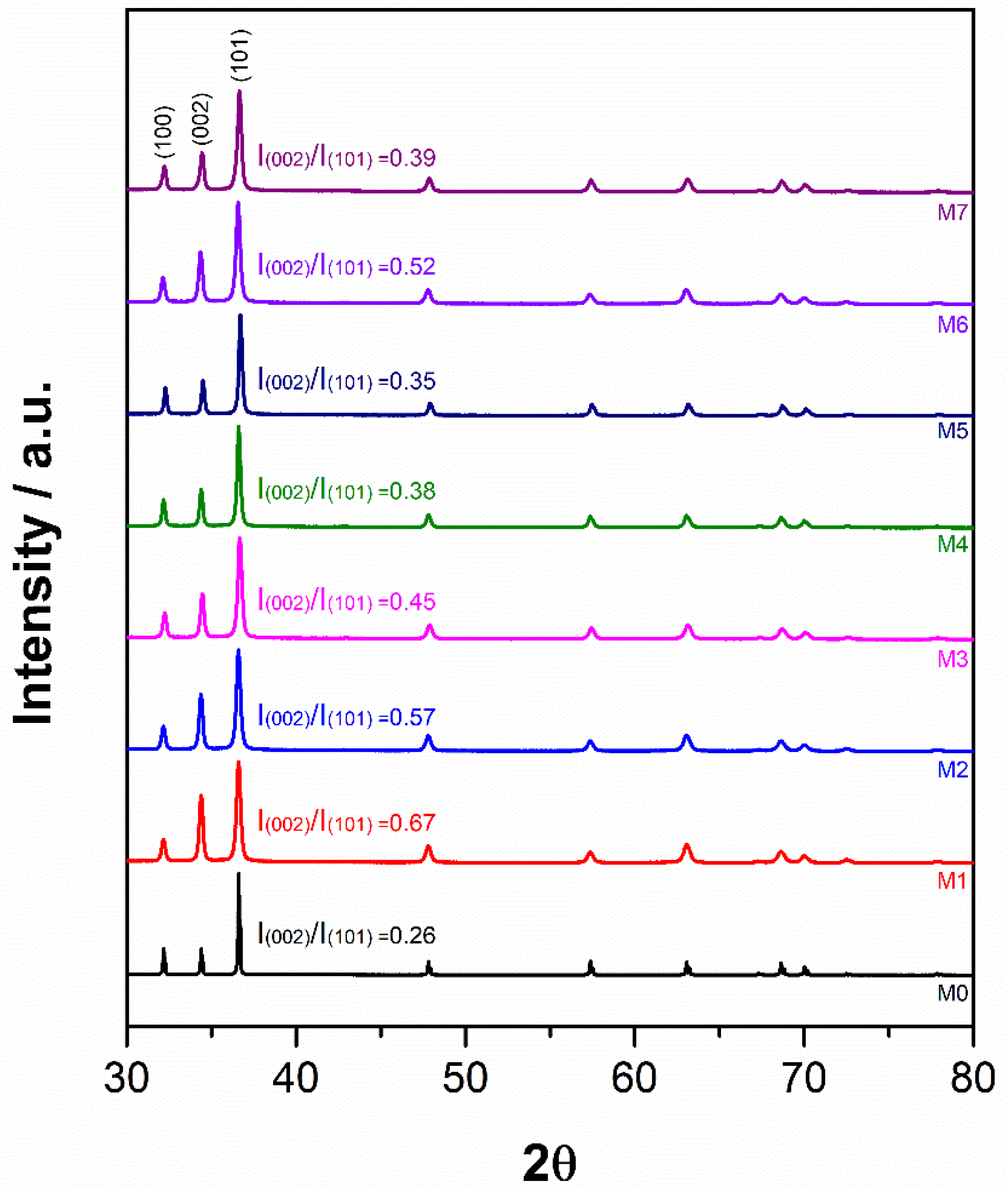Effect of Ball Size on the Microstructure and Morphology of Mg Powders Processed by High-Energy Ball Milling
Abstract
:1. Introduction
2. Materials and Methods
3. Results
3.1. Morphology of Powders
3.2. Microstructure of Powders
4. Discussion
5. Conclusions
Author Contributions
Funding
Institutional Review Board Statement
Informed Consent Statement
Data Availability Statement
Conflicts of Interest
References
- Ghayour, H.; Abdellahi, M.; Bahmanpour, M. Optimization of the high energy ball-milling: Modeling and parametric study. Powder Technol. 2016, 291, 7–13. [Google Scholar] [CrossRef]
- Liao, H.; Chen, J.; Peng, L.; Han, J.; Yi, H.; Zheng, F.; Wu, Y.; Ding, W. Fabrication and characterization of magnesium matrix composite processed by combination of friction stir processing and high-energy ball milling. Mater. Sci. Eng. A 2017, 683, 207–214. [Google Scholar] [CrossRef]
- Phasha, M.; Maweja, K.; Babst, C. Mechanical alloying by ball milling of Ti and Mg elemental powders: Operation condition considerations. J. Alloys Compd. 2010, 492, 201–207. [Google Scholar] [CrossRef]
- Kim, H.N.; Kim, J.W.; Kim, M.S.; Lee, B.H.; Kim, J.C. Effects of Ball Size on the Grinding Behavior of Talc Using a High-Energy Ball Mill. Minerals 2019, 9, 668. [Google Scholar] [CrossRef] [Green Version]
- Wu, Z.M.; Liang, Y.X.; Fan, Y.; Wang, P.P.; Du, J.L.; Zhao, Y.B.; Fu, E.G. The ball to powder ratio (BPR) dependent morphology and microstructure of tungsten powder refined by ball milling. Powder Technol. 2018, 339, 256–263. [Google Scholar] [CrossRef]
- Fahimpour, V.; Sadrnezhaad, S.K. Breakage Mechanism of Mg During Ball Milling with NaCl, KCl and Urea for Nanopowder Production. Trans. Indian Inst. Met. 2017, 70, 1783–1793. [Google Scholar] [CrossRef]
- Chaubey, A.K.; Scudino, S.; Khoshkhoo, M.S.; Prashanth, K.G.; Mukhopadhyay, N.K.; Mishra, B.K.; Eckert, J. Synthesis and characterization of nanocrystallineMg-7.4%Al powders produced by mechanical alloying. Metals 2013, 3, 58–68. [Google Scholar] [CrossRef] [Green Version]
- Restrepo, A.H.; Ríos, J.M.; Arango, F.; Correa, E.; Zuleta, A.A.; Valencia-Escobar, A.; Bolivar, F.J.; Castaño, J.G.; Echeverría, F.E. Characterization of titanium powders processed in n-hexane by high-energy ball milling. Int. J. Adv. Manuf. Technol. 2020, 110, 1681–1690. [Google Scholar] [CrossRef]
- Cai, X.C.; Sun, B.R.; Liu, Y.; Zhang, N.; Zhang, J.H.; Yu, H.; Huang, J.Y.; Peng, Q.M.; Shen, T.D. Selection of grain-boundary segregation elements for achieving stable and strong nanocrystalline Mg. Mater. Sci. Eng. A 2018, 717, 144–153. [Google Scholar] [CrossRef]
- Hwang, S.; Nishimura, C.; McCormick, P. Mechanical milling of magnesium powder. Mater. Sci. Eng. A 2001, 318, 22–33. [Google Scholar] [CrossRef]
- Çakmak, G.; Öztürk, T. Milling of magnesium powders without additives. Powder Technol. 2013, 237, 484–488. [Google Scholar] [CrossRef]
- Fahimpour, V.; Sadrnezhaad, S.K. Magnesium nanopowder for hydrogen absorption and ammonium perchlorate decomposition. Mater. Lett. 2012, 85, 128–131. [Google Scholar] [CrossRef]
- Galindez, Y.; Correa, E.; Zuleta, A.A.; Valencia-Escobar, A.; Calderon, D.; Toro, L.; Chacón, P.; Echeverría, E.F. Improved Mg–Al–Zn Magnesium Alloys Produced by High Energy Milling and Hot Sintering. Met. Mater. Int. 2019. [Google Scholar] [CrossRef]
- Suśniak, M.; Pałka, P.; Karwan-Baczewska, J. Influence of milling time on the crystallite size of AlSi5Cu2/SiC composite powder. Arch. Metall. Mater. 2016, 61, 977–980. [Google Scholar] [CrossRef]
- Ghasemi, A.; Penther, D.; Kamrani, S. Microstructure and nanoindentation analysis of Mg-SiC nanocomposite powders synthesized by mechanical milling. Mater. Charact. 2018, 142, 137–143. [Google Scholar] [CrossRef]
- Hosseini-Gourajoubi, F.; Pourabdoli, M.; Uner, D.; Raygan, S. Effect of process control agents on synthesizing nano-structured 2Mg–9Ni–Y catalyst by mechanical milling and its catalytic effect on desorption capacity of MgH2. Adv. Powder Technol. 2015, 26, 448–453. [Google Scholar] [CrossRef]
- Park, K.; Park, J.; Kwon, H. Effect of intermetallic compound on the Al-Mg composite materials fabricated by mechanical ball milling and spark plasma sintering. J. Alloys Compd. 2018, 739, 311–318. [Google Scholar] [CrossRef]
- Kamrani, S.; Penther, D.; Ghasemi, A.; Riedel, R.; Fleck, C. Microstructural characterization of Mg-SiC nanocomposite synthesized by high energy ball milling. Adv. Powder Technol. 2018, 29, 1742–1748. [Google Scholar] [CrossRef]
- Bemanifar, S.; Rajabi, M.; Hosseinipour, S.J. Microstructural Characterization of Mg-SiC Nanocomposite Powders Fabricated by High Energy Mechanical Milling. Silicon 2017, 9, 823–827. [Google Scholar] [CrossRef]
- Ponhan, K.; Tassenberg, K.; Weston, D.; Nicholls, K.G.M.; Thornton, R. Effect of SiC nanoparticle content and milling time on the microstructural characteristics and properties of Mg-SiC nanocomposites synthesized with powder metallurgy incorporating high-energy ball milling. Ceram. Int. 2020, 46, 26956–26969. [Google Scholar] [CrossRef]
- Jabbari-Taleghani, M.A.; Torralba, J.M. Hot workability of nanocrystalline AZ91 magnesium alloy. J. Alloys Compd. 2014, 595, 1–7. [Google Scholar] [CrossRef] [Green Version]
- Huang, J.Y.; Wu, Y.K.; Ye, H.Q. Ball milling of ductile metals. Mater. Sci. Eng. A 1995, 199, 165–172. [Google Scholar] [CrossRef]
- Rousselot, S.; Bichat, M.P.; Guay, D.; Roué, L. Structure and electrochemical behaviour of metastable Mg50Ti50 alloy prepared by ball milling. J. Power Sour. 2008, 175, 621–624. [Google Scholar] [CrossRef]
- Chen, H.; Xiao, H.; Wang, Y.; Liu, J.; Yang, Q.; Feng, X. Insight into the energy conversion and structural evolution of magnesium hydride during high-energy ball milling for its controllable synthesis. J. Alloys Compd. 2020, 836, 155312. [Google Scholar] [CrossRef]
- Alaneme, K.K.; Okotete, E.A. Enhancing plastic deformability of Mg and its alloys—A review of traditional and nascent developments. J. Magnes. Alloy. 2017, 5, 460–475. [Google Scholar] [CrossRef]
- Asano, K.; Enoki, H.; Akiba, E. Synthesis process of Mg-Ti BCC alloys by means of ball milling. J. Alloys Compd. 2009, 486, 115–123. [Google Scholar] [CrossRef]
- Fecht, H.J.; Hellstern, E.; Fu, Z.; Johnson, W.L. Nanocrystalline metals prepared by high-energy ball milling. Metall. Trans. A 1990, 21, 2333–2337. [Google Scholar] [CrossRef]
- Kim, K.R.; Ahn, J.W.; Kim, G.H.; Han, J.H.; Cho, K.K.; Roh, J.S.; Kim, W.J.; Kim, H.S. Corrosion behavior of magnesium powder fabricated by high-energy ball milling and spark plasma sintering. Met. Mater. Int. 2014, 20, 1095–1101. [Google Scholar] [CrossRef]
- Zhou, H.; Hu, L.; Sun, H.; Chen, X. Synthesis of nanocrystalline Mg-based Mg-Ti composite powders by mechanical milling. Mater. Charact. 2015, 106, 44–51. [Google Scholar] [CrossRef]
- El-Eskandarany, M.S. Controlling the powder milling process. In Mechanical Alloying: Nanotechnology, Materials Science and Powder Metallurgy; Elsevier: Amsterdam, The Netherlands, 2015; pp. 48–83. ISBN 9781455777525. [Google Scholar]
- Zou, C.; Long, Y.; Zheng, X.; Lin, H.T.; Zhang, F. Effect of ball sizes on synthesis of OsB2 powders by mechanical alloying. Ceram. Int. 2017, 43, 17111–17115. [Google Scholar] [CrossRef]
- Hong, S.-M.; Park, J.-J.; Park, E.-K.; Kim, K.-Y.; Lee, J.-G.; Lee, M.-K.; Rhee, C.-K.; Lee, J.K. Fabrication of titanium carbide nano-powders by a very high speed planetary ball milling with a help of process control agents. Powder Technol. 2015, 274, 393–401. [Google Scholar] [CrossRef]
- Hlabangana, N.; Danha, G.; Muzenda, E. Effect of ball and feed particle size distribution on the milling efficiency of a ball mill: An attainable region approach. S. Afr. J. Chem. Eng. 2018, 25, 79–84. [Google Scholar] [CrossRef]
- Liang, Y.X.; Wu, Z.M.; Fu, E.G.; Du, J.L.; Wang, P.P.; Zhao, Y.B.; Qiu, Y.H.; Hu, Z.Y. Refinement process and mechanisms of tungsten powder by high energy ball milling. Int. J. Refract. Met. Hard Mater. 2017, 67, 1–8. [Google Scholar] [CrossRef]
- Yazdani, A.; Hadianfard, M.J.; Salahinejad, E. A system dynamics model to estimate energy, temperature, and particle size in planetary ball milling. J. Alloys Compd. 2013, 555, 108–111. [Google Scholar] [CrossRef]
- Burmeister, C.; Titscher, L.; Breitung-Faes, S.; Kwade, A. Dry grinding in planetary ball mills: Evaluation of a stressing model. Adv. Powder Technol. 2018, 29, 191–201. [Google Scholar] [CrossRef]
- Ruiz-Navas, E.M.; Edil da Costa, C.; Velasco López, F.; Torralba Castelló, J.M. Aleación mecánica: Método de obtención de polvos metálicos y de materiales compuestos. Rev. Metal. 2000, 36, 279–286. [Google Scholar] [CrossRef] [Green Version]
- Suryanarayana, C. Mechanical Alloying: A Novel Technique to Synthesize Advanced Materials. Research 2019, 2019, 4219812. [Google Scholar] [CrossRef] [Green Version]
- Cao, P.; Lu, L.; Lai, M.O. Grain growth and kinetics for nanocrystalline magnesium alloy produced by mechanical alloying. Mater. Res. Bull. 2001, 36, 981–988. [Google Scholar] [CrossRef]
- Yu, H.; Sun, Y.; Hu, L.; Wan, Z.; Zhou, H. The effect of Ti addition on microstructure evolution of AZ61 Mg alloy during mechanical milling. J. Alloys Compd. 2017, 704, 537–544. [Google Scholar] [CrossRef]
- Wang, X.; Jiang, L.; Zhang, D.; Rupert, T.J.; Beyerlein, I.J.; Mahajan, S.; Lavernia, E.J.; Schoenung, J.M. Revealing the deformation mechanisms for room-temperature compressive superplasticity in nanocrystalline magnesium. Materialia 2020, 11, 100731. [Google Scholar] [CrossRef]





| Sample | Stage | Ball Size (mm) | Rotational Speed (rpm) | BPR | Time (h) |
|---|---|---|---|---|---|
| M0 | 0 | - | - | - | - |
| M1 | 1 | 10 | 1000 | 12:1 | 8 |
| M2 | 2 | 3 | 1500 | 11:1 | 4 |
| M3 | 2 | 3 | 1700 | 11:1 | 2 |
| M4 | 2 | 1 | 1700 | 2:1 | 1 |
| M5 | 2 | 1 | 1700 | 1:1 | 2 |
| M6 | 3 | 3 | 1700 | 11:1 | 2 |
| M7 | 3 | 1 | 1700 | 4:1 | 1 |
| Sample | Crystallite Size (nm) | Lattice Strain (%) | Dislocation Density (×1014 m−2) | Lattice Parameter (Å) | |
|---|---|---|---|---|---|
| (a) | (b) | ||||
| M0 | 121.3 | 0.101 | 0.68 | 3.2094 | 5.2110 |
| M1 | 35.0 | 0.326 | 8.16 | 3.2119 | 5.2128 |
| M2 | 35.8 | 0.319 | 7.80 | 3.2117 | 5.2133 |
| M3 | 35.0 | 0.326 | 8.16 | 3.2119 | 5.2128 |
| M4 | 47.0 | 0.245 | 4.53 | 3.2105 | 5.2122 |
| M5 | 51.0 | 0.226 | 3.84 | 3.2061 | 5.2060 |
| M6 | 33.5 | 0.341 | 8.91 | 3.2123 | 5.2145 |
| M7 | 35.1 | 0.324 | 8.12 | 3.2092 | 5.2101 |
Publisher’s Note: MDPI stays neutral with regard to jurisdictional claims in published maps and institutional affiliations. |
© 2021 by the authors. Licensee MDPI, Basel, Switzerland. This article is an open access article distributed under the terms and conditions of the Creative Commons Attribution (CC BY) license (https://creativecommons.org/licenses/by/4.0/).
Share and Cite
Rios, J.; Restrepo, A.; Zuleta, A.; Bolívar, F.; Castaño, J.; Correa, E.; Echeverria, F. Effect of Ball Size on the Microstructure and Morphology of Mg Powders Processed by High-Energy Ball Milling. Metals 2021, 11, 1621. https://doi.org/10.3390/met11101621
Rios J, Restrepo A, Zuleta A, Bolívar F, Castaño J, Correa E, Echeverria F. Effect of Ball Size on the Microstructure and Morphology of Mg Powders Processed by High-Energy Ball Milling. Metals. 2021; 11(10):1621. https://doi.org/10.3390/met11101621
Chicago/Turabian StyleRios, Jesus, Alex Restrepo, Alejandro Zuleta, Francisco Bolívar, Juan Castaño, Esteban Correa, and Félix Echeverria. 2021. "Effect of Ball Size on the Microstructure and Morphology of Mg Powders Processed by High-Energy Ball Milling" Metals 11, no. 10: 1621. https://doi.org/10.3390/met11101621
APA StyleRios, J., Restrepo, A., Zuleta, A., Bolívar, F., Castaño, J., Correa, E., & Echeverria, F. (2021). Effect of Ball Size on the Microstructure and Morphology of Mg Powders Processed by High-Energy Ball Milling. Metals, 11(10), 1621. https://doi.org/10.3390/met11101621







